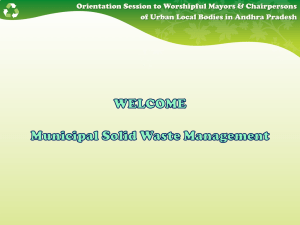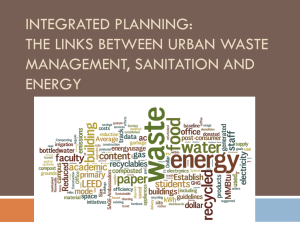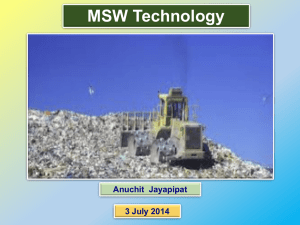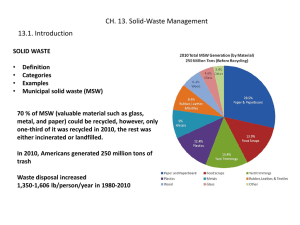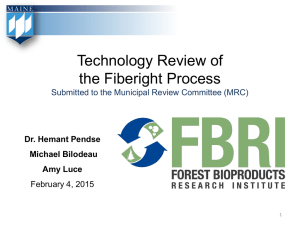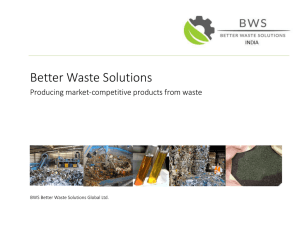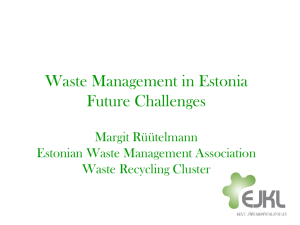Waste to Wealth by Dr Sivapalan Kathiravale
advertisement
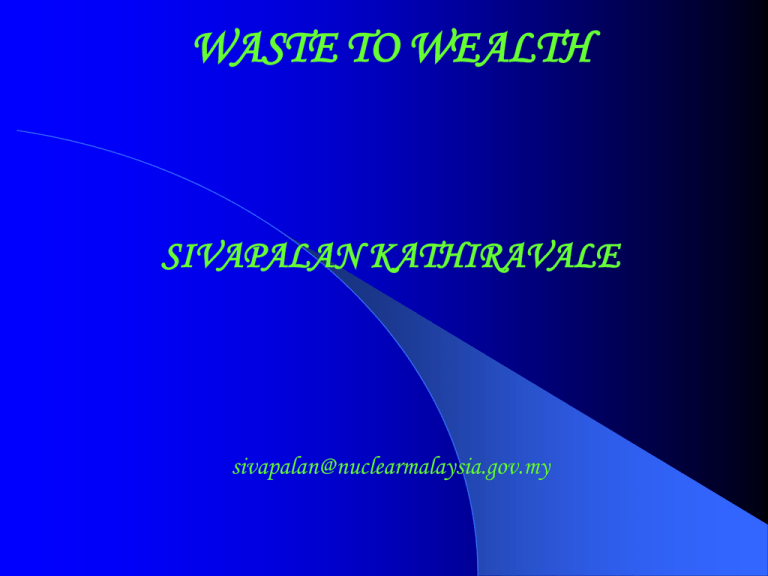
WASTE TO WEALTH SIVAPALAN KATHIRAVALE sivapalan@nuclearmalaysia.gov.my Introduction The need to understand waste Waste generation rates Waste management trends Effect on the Environment Waste to Wealth Conclusion Global Perspective of Municipal Solid Waste Generation Rates and The Respective Management Costs Units Low Income Middle Income High Income Mixed Urban Waste – Large City kg/cap/day 0.50 to 0.75 0.55 to 1.10 0.75 to 2.20 Mixed Urban Waste – Medium City kg/cap/day 0.35 to 0.65 0.45 to 0.75 0.65 to 1.50 Residential Waste Only kg/cap/day 0.25 to 0.45 0.35 to 0.65 0.55 to 1.00 Average Income from GNP USD/cap/yr 370 2,400 22,000 Collection Cost USD/ton 10 to 30 30 to 70 70 to 120 Transfer Cost USD/ton 3 to 8 5 to 15 15 to 20 Open Dumping Cost USD/ton 0.5 to 2 1 to 3 5 to 10 Sanitary Landfill Cost USD/ton 3 to 10 8 to 15 20 to 50 Tidal Land Reclamation Cost USD/ton 3 to 15 10 to 40 30 to 100 Composting Cost USD/ton 5 to 20 10 to 40 20 to 60 Incineration Cost USD/ton 40 to 60 30 to 80 70 to 100 Total cost without Transfer USD/ton 13 to 40 38 to 85 90 to 170 Total cost with Transfer USD/ton 17 to 48 43 to 100 105 to 190 % 0.7 to 2.6 0.5 to 1.3 0.2 to 0.5 Cost as % of Income Socio-economic data, generation rates and major waste components in some countries City Country Socio-economic factors W T PD P/DW GNP POP USA Australia Japan France Italy 1000 15 450 620 25 30 700 15 40 694 1250 10 4 000 580 14 700 4.2 4.2 7.0 2.5 4.9 12 800 4 100 4 910 18 400 7 000 Spain Singapore Philipines Taiwan Nigeria 410 440 64 220 70 14 290 29 26 472 27 983 22 1 250 30 200 4.2 3.9 5.0 4.2 4.5 5 000 3.19 4 000 2.44 807 1.63 2.50 2 000 1.00 India Bangldeh Pakistan Indonesia Burma 50 25 340 45 32 24 1 300 7.0 26 3 750 6.0 29 1 300 5.5 24 700 8.0 26 200 6.0 Municipal Waste MW Major waste components (% by weight) Paper Plastic Food Metal Glass High Income New York Sydney Tokyo Paris Rome 9.12 3.23 11.60 2.18 2.88 720 690 400 590 460 35 38 38 30 18 10 0.1 11 1 4 22 13 23 30 50 13 11 4 4 3 390 - 21 43 17 8 17 6 4 2 4 45 5 43 25 43 3 3 2 1 5 - 3 2 0.5 2 1 0.5 1 0.5 3 4 9 18 7 4 4 Medium Income Madrid Singapore Manila Taipei Kano 4 1 5 3 2 Low Income Banglore Dacca Karachi Jakarta Rangoon 320 200 1 890 474 120 2.91 1.31 5.10 6.50 2.60 65 40 56 82 80 0.4 1 0.5 4 3 0.2 9 0.5 0.5 6 Fo od /O rg M anic ix Pa pe N H ig ews r h Pr G Co rad int rru e P ga ap er te Pl d Pa as tic per Pl (Rig as id ti ) Pl c (F as tic lim) (F oa m Pa ) m pe rs Ru Te xt bb er ile /L ea th er W oo d G Y la ar ss d G (C la ss l ( C ear ) ol ou re d Fe ) r N on rou s -F er r o A lu us Ba m tte rie iniu s/H m az ar ds O th Fi O er O n e th rg er In anic -O rg an ic O th er s Percentage Composition of MSW generated in Kuala Lumpur 70 Min Average Max 60 50 40 30 20 10 0 Solid Waste Management Problem in Malaysia MSW Generation 17,000 t/day (2003), 30,000 t/day (2020) Kuala Lumpur Generates 2,500 t/day 95 – 97% of MSW is Land filled Currently 112 Disposal Sites (2002) 43% Open Dump, only 6.3% Sanitary Landfill (SLF) 50% Remaining Lifespan < 5 yrs SOLID WASTE MANAGEMENT Environmentally Sustainable •Reduce the Environmental Impact •Reduce Energy Consumption •Reduce Pollution of Land, Air & Water •Reduce Loss of Amenity Economically Sustainable •Balance between Cost versus Env. Impact •BATNEEC, BPEO LEADING TO IWMS ROLE of INTERGRATED WASTE MANAGEMENT SYSTEM(IWMS) Energy Raw Material Energy Recovery I.W.M Material Recovery Landfill Amount of waste collected and the management methods Country Data latest year available Municipal waste collected (1000 tonnes) Population served by municipal waste collection (%) Municipal waste collected per capita served (kg) Municipal waste landfilled (%) Municipal waste incinerated (%) Municipal waste recycled/ composted (kg) Europe Sweden 2001 3 930 ... ... 22.4 38.2 38.7 United Kingdom 2001 34 851 ... ... 79.9 7.3 12.3 Bulgaria 2002 3 199 81.1 495 99.7 ... ... Czech Republic 2002 2 845 100.0 278 70.3 14.0 ... Denmark 2002 3 587 100.0 670 8.3 58.3 34.6 North & Central America Belize 2000 62 48.6 532 100.0 ... ... Canada 2000 10 870 ... ... ... ... 32.2 Costa Rica 2000 71 ... ... ... ... ... Mexico 2002 32 174 86.0 367 97.6 0.0 2.4 United States 2001 207 957 100.0 722 55.7 14.7 29.7 Cont’ South America Bolivia 2002 662 ... ... ... ... ... Chile 2002 5 558 ... ... 41.0 ... ... Colombia 1998 7 430 ... ... ... ... ... Peru 2001 1 444 100.0 … 64.6 ... ... Uruguay 2000 910 … … … … … Algeria 2003 8 500 ... ... 99.9 ... 0.1 Benin 2002 986 23.0 654 0.0 0.0 ... Egypt 2000 15 000 ... ... ... ... ... Madagascar 2002 151 100.0 … 100.0 0.0 0.0 Mauritius 2003 351 95.0 303 100.0 ... ... China, Hong Kong SAR 2002 5 399 100.0 773 63.7 ... 36.3 Japan 2000 52 362 100.0 412 5.9 77.0 15.0 Cyprus 2002 500 ... 709 90.0 0.0 0.0 Singapore 2002 4 402 ... ... 3.7 55.0 41.3 Thailand 2000 13 972 ... ... ... 0.8 14.3 Australia 1999 13 200 ... ... 95.0 0.0 7.3 New Zealand 1999 1 541 ... ... 84.7 ... 15.3 Africa Asia Oceania Waste Management/Thermal Treatment Trends Gasification Pyrolysis Mass Burn Sanitary Landfill Dumping Environmentally the best Economically the best Hydrogen Global New Approach 4.RDF Burn /GAM Electricity ? MW Export Ash MSW MRF/ RDF Plant Organics Digestate 1.Reduction 2. Recycle Materials SLF 3.A.D/ Electricity Composting ? MW Export Compost Selection is not simple, depends on: Waste Size, Composition and Need for ReProcessing Choice of Recycling Options-Energy, Chemicals, Slag Regulation Local Conditions Flexibility with Regards to Waste Stream Technology Maturity and Track Record Economics Issues Public Acceptance Greenhouse gas emissions of different waste management systems + CO2 equivalents per annum - Landfill + Gas recovery + Power Production Landfill Mix waste combustion plant + power production Energy SRF production cogasification in coal boiler Recycling SRF and paper fibre recovery + cogasification in coal boiler Total GHG emissions from the MSW incineration and landfill (Germany) Emission in 2002 [million t CO2eq] Total Emissions Landfill MSW Incineration Carbon dioxide CO2 863.5 - 6.45 Methane CH4 74.5 13.7 - Nitrous oxide N2O 49.5 - 0.03 HFCS 8.2 - - PFCS 0.7 - - SF6 4.1 - - Total 1000.5 13.7 6.49 Greenhouse gas emissions from electricity production 1 tonne MSW MSW Incineration 1100 kg CO2 (220 kg fossil and 880 kg biogenic) 600 kWhe Coal Coal Combustion 592 kg CO2 600 kWhe equivalent 1 tonne MSW Landfill 1610 kg CO2 With out gas utilization Net reduction in CO2 = 220-592-1610 = -1982 kg What is Dioxin A Common Name for a Group of Chemicals called Polychlorinated dibenzo-p-dioxins (PCDD), furans(PCDF) and certain PCBs As its name suggests, it forms from a chemical combination of Carbon, Hydrogen, Oxygen and Chlorine Pure dioxins are colorless solids or crystals Source of Dioxin In Japan, more than 80% dioxin comes from incineration In the USA, about 38% comes from incineration In the Ireland, only 0.32% comes from incinerators whereas the biggest sources are from accidental fires and illegal domestic waste combustion (58%). Note: Ireland produces about 38 g TEQ/yr compared to other European countries ranging from 50 – 1123 g-TEQ/yr. I.e depends on the industrialization and the use of many old incinerators Dioxin Level in Environment Malaysia Air (pg/Nm3) 0.1- 0.17 Soil (pg/g) MSW (pg/g) Germany 0.1 Japan Std 0.6 (MINT,2003) (Vehlow,2000) (Sakai, 2000) 2-5 1-10 1000 (MINT, 2003) (Vehlow, 2000) (Sakai, 2000) 11-25 20-100 NA (MINT, 2003) (Vehlow, 2000) Pathways for processing of municipal solid waste Processing Intermediate Products Materials For Market Conversion To Energy Incineration Compost MSW Mechanic Separati al on Anarobic Digestion Biodegradable Fraction Secondary Raw material Glass, Metals, Aluminium etc Pyrolisis Gasification Solid Recovered Fuels Combustion Co-utilisation with Fossil Fuels SA K K ECU/ton 400 U S Si ng A ap o M re al ay si a M al ay si a U U U Au st ria Be lg iu Be m lg iu m D en m ar Fi k nl an Fi d nl an G er d m an G er y m an G y N ree et he ce r N l an et he ds rl a nd s Sp ai n Sp Sw a in ee d Sw en ee de n Cost comparison between land filling and incineration Incineration Landfill 350 300 250 200 150 100 50 0 Amount of Energy Recoverable from MSW by Various Treatment Technologies [15] Material Treatment Technology Conversion Efficiency Calorific Value of Fuel Energy Recoverable / ton of Fuel Total Energy Recovered (based on 1500 tons/day Energy Recoverable (Normalized to per ton of MSW Input) MSW Incineration WTE - 25 % 2200 kcal/kg 639 kW.hr 960 MW.hr 639 kW.hr MSW Incineration WTE - 25 % 1500 kcal/kg 436 kW.hr 655 MW.hr 436 kW.hr MSW Incineration WTE - 25 % 800 kcal/kg 233 kW.hr 350 MW.hr 233 kWhr RDF Incineration MSW to RDF - 30%, WTE - 25% 3500 kcal/kg 1017 kW.hr 458 MW.hr 305 kW.hr MSW Anaerobic Digestion, MSW to Digester – 60%, Biogas to energy – 25% 5000 kcal/m3 218 kW.hr 196 MW.hr 131 kW.hr MSW Anaerobic Digestion, MSW to Digester – 60%, Biogas to energy with steam recovery 80% 5000 kcal/m3 697 kW.hr 627 MW.hr 418 kW.hr MSW Anaerobic Digestion and Fuel Cell MSW to Digester – 60%, Biogas to energy by Fuel Cell – 50% 241.83 kJ /mol H 585 kW.hr 526 MW.hr 351 kW.hr Conclusion Waste generated and managed in a proper manner – could be advantageous to the environment The environment has already suffered enough from the actins of it’s inhabitants Education and realization is necessary to ensure sustainability The Challenges is how and what action should be taken? Matters to ponder! Most of current technology is focused on treating waste that has already been generated What about reducing the need to manufacture less for less consumption? Ensuring manufacturing processes are 110% efficient and do not produce waste at all. How to contain the huge appetite for modern lifestyle? Ensuring zero waste production by the general population? Thank You THANK YOU AND HELP PRESERVE THIS
